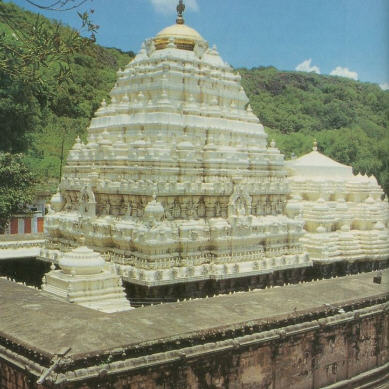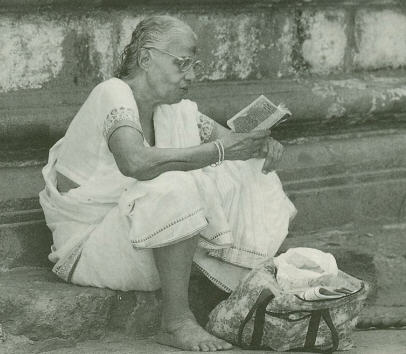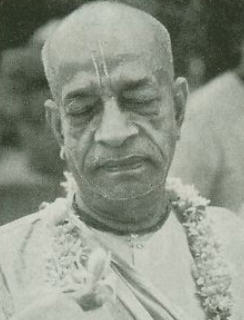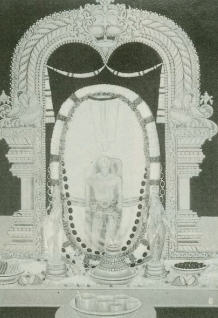A visit to the south Indian shrine of Simhacalam.
SIMHACALAM, in the south Indian state of Andhra Pradesh, is a place of scenic beauty, set as it is among the green hills overlooking Visakhapatnam and the sea. Yet people don't come merely for the scenic beauty; they come to visit the Simhacalam temple.

Over the course of years, many old temples in south India have fallen into decline, but this one hasn't, largely because of the growth of nearby Visakhapatnam, which has become a major city, with a population of over one million. The city serves as a natural reservoir of visitors. Many pilgrims also come from Orissa, the next state north.
Previously, up to the time of King Prataparudra, in the sixteenth century, this part of Andhra Pradesh was ruled from Orissa. And especially in the southernmost district of Orissa, Ganjam district, many, many people worship Lord Nrsimhadeva, Lord Krsna in His form as half lion, half man. The Simhacalam temple, dedicated to Lord Nrsimhadeva, is the Nrsimha temple nearest Ganjam, so throughout the year many pilgrims come from Ganjam, and especially on Candana-yatra.
Candana-yatra is the day the Lord gives darsana that is, when His form is visible to devotees. Otherwise He appears like a Siva-linga covered with sandalwood pulp (candana). Throughout the year people come and take darsana of Him like this, in His nitya rupa, the constant form that you see, the form covered in candana. The nija rupa, His actual form, is revealed only on the day of Candana-yatra, when the priests break the candana covering and then again put the candana back. On Candana-yatra, thousands and thousands of people come from south Orissa especially, and also from Andhra Pradesh, and completely crowd out the whole area to take darsana of the Lord in this form.
The approach up the hill to the temple has about one thousand steps, and climbing them gives a great sense of achievement. Now, like many temples, Simhacalam has a bus service going up, which is convenient and much easier on the legs, but the real die-hard pilgrims still climb step by step by step, and their sense of meeting the Lord is heightened by the difficulty they go through to reach Him. Previously, of course, pilgrims would walk for seven days or two weeks or whatever to reach a holy place, and that walking would heighten their mood even more.
We have come on a Saturday, it's the full-moon day, and it's during the summer holidays, so there is a big crowd, with thousands of people coming and going. Traditionally in Andhra Pradesh, Monday is the day for visiting Siva temples and Saturday any other temple. Those who are not vegetarian observe vegetarianism on this day and visit temples, so we have a big crowd here.
Another time I came on a quiet day, at eight o'clock, just when the temple opened, and I stayed as long as I liked without disturbance, but today because of so much rush there's a different kind of atmosphere.
Everything is well organized for taking darsana, getting on buses, and so on, but with only three buses going up and down the hill, on a big day like this it's a bit of a strain on the transport system, and there's a lot of hurry-scurry. The bus winds its way up and down the ghats, past signs in Telugu and Oriya, and a few in Hindi also. Hairpin bends. Sheer drops. It's quite exciting.
On the Hill

As you reach the top of the hill, the bus stops, and you're welcomed by the sound of Visnu-sahasranama, one thousand names of Lord Visnu, played over loudspeakers from the well-known cassette by Laksmi Subhramanyam.
You see plenty of people walking around with their cloth wet, as it's a tradition in these holy places to bathe in a nearby sacred lake before taking darsana.
Another part of the traditional vow is to get your head shaved before taking the bath. Here in south India, particularly Andhra, this is common not only for men and children but even for women.
The priests of the Simhacalam temple belong to the Sri Sampradaya, the line that follows the revered devotee and philosopher Ramanuja. Simhacalam is one of the 108 places recognized by the Sri Sampradaya asdivya-desams, spiritual places in this material world. The temple functions are performed by Sri Vaisnava priests as they have been since Ramanuja visited here nine centuries ago. Most of the temples of the Sri Sampradaya are connected with at least one of the Alvars, the great teachers previous to Ramanuja. This one is connected with Nama Alvar, who has written songs in praise of the Simhacalam Deity.
Lining the steps to the entrance of the temple (and also the steps up the hill), there's the usual line of beggars collecting rice, and women offering coins. Following custom, you give one rupee (100 paisa) and they give you 90 paisa in small coins back. The coins you give to the beggars at the different shrines, a little bit here and a little bit there, because at holy places you are supposed to give charity.
There are, of course, fruit sellers, flower sellers, sellers of coconuts to offer to the Deities, and sellers of books and cassettes, connected with the holy place. There are also sadhus, with different kinds of tilaka and dress, adding to the color. It's a small world in itself.
Approaching the Lord
At the main entrance of the temple you see commemorative footprints of Lord Caitanya Mahaprabhu installed in 1930 by Srila Bhaktisiddhanta Sarasvati Goswami Maharaja, Srila Prabhupada's spiritual master, who installed Lord Caitanya's footprints in many places Lord Caitanya visited throughout India.
As soon as you enter the temple, you're hit by the smell of coconut and camphor. Thousands of people come every day, and they each bring a coconut, which is ceremonially broken to the chanting of mantras, and then a camphor light is burned, so the smell permeates the temple.
When you walk in, the temple is dark. If lighting is used, it's used sparingly, to retain that dark atmosphere. And you go through long passages with carvings on the walls and little chapels with deities of Alvars and different forms of Laksmi, the consort of Lord Visnu. The Sri Sampradaya comes originally from Laksmi, so its devotees prominently worship different forms of Laksmi. Then eventually you come to the sanctum sanctorum and hear the mantras being chanted, creating a very special atmosphere.
The idea of bhakti, devoting oneself to God, is a central part of Indian culture, but although pure bhakti is praised in song and literature, not everyone comes to the temple out of pure devotion. Their devotion is mixed. Most people come to worship with the idea of being rewarded with material boons.
This particular temple is famous for giving childless mothers the boon of children. Just outside the Deity room stands a pillar decorated with cloth and surrounded by silver plates and flower garlands that women are supposed to embrace, saying certain prayers and performing worship, to ask the Lord to grant that desire. And in general people come praying for money, family happiness, and removal of difficulties in material life.
But although that's still a long way from pure devotional service, it's far better than being a gross materialist with no religious idea at all. And some devotees, of course, come with only pure devotion in mind.
In various areas of the temple you'll find brahmanas engaged in puja or studying Sanskrit books and reciting Sanskrit texts. Other brahmanas have duties such as cleaning the temple, carrying vegetables for the Deity, carrying firewood for cooking, carrying the Lord in procession so many different functions. Traditionally these duties are done generation after generation by the same families, who live just outside the temple precincts.
Going for darsana is a big rush. One man is assigned to push everyone along in line. And right in front of the Deities there are four or five men pushing and hoarsely urging everyone to move on. Still, being fond of ISKCON devotees, they allow me to stand to the side of the railings and offer my prayers in peace.
In the sanctum sanctorum the repeated chant of Om Namo Narayana, the chant of the Sri Sampradaya, plays over loudspeakers. Despite all the push and shove, it is exhilarating to be at this unique temple of Laksmi Varaha-Nrsimha Svami, a form of the Lord not found anywhere else.
Bhakti Vikasa Swami comes from England but has lived in India for many years. He now teaches Krsna consciousness at the ISKCON center in Vallabh Vidyanagar, Gujarat.
Lord Caitanya's Stay At Simhacalam
LORD CAITANYA Mahaprabhu, Krsna Himself in the role of a devotee of Krsna, visited Simhacalam about half a century ago, during His tour of south India. The Caitanya-caritamrta (Madhya 3.83-8) records His visit this way:
"According to His previous program, Lord Sri Caitanya Mahaprabhu went forward on His tour and after some days arrived at the place of pilgrimage known as Jiyada-nrsimha [Simhacalam].
"After seeing the Deity Lord Nrsimha in the temple, Sri Caitanya Mahaprabhu offered respectful obeisances by falling flat. Then, in ecstatic love, He performed various dances, chanted, and offered prayers.
sri-nrsimha, jaya nrsimha,
jaya jaya nrsimha
prahladesa jaya padma-mukha-padma-bhrnga
" 'All glories to Nrsimhadeva! All glories to Nrsimhadeva, who is the Lord of Prahlada Maharaja and, like the honeybee, is always engaged in beholding the lotuslike face of the goddess of fortune.'
ugro 'py anugra evayam
sva-bhaktanam nr-kesari
kesariva sva-potanam
anyesam ugra-vikramah
" 'Although very ferocious, the lioness is very kind to her cubs. Similarly, although very ferocious to nondevotees like Hiranyakasipu, Lord Nrsimhadeva is very, very soft and kind to devotees like Prahlada Maharaja.'
"In this way Lord Caitanya Mahaprabhu recited different verses from the sastra [scripture]. The priest of Lord Nrsimhadeva then brought garlands and the remnants of Lord Nrsimhadeva's food and offered to them to Sri Caitanya Mahaprabhu.
"As usual, a brahmana offered Sri Caitanya Mahaprabhu an invitation [to visit and accept lunch at his home]. The Lord passed the night in the temple and then commenced His tour again."
Festivals at Simhacalam
THE DEVOTEES at the Simhacalam temple celebrate various festivals in honor of the Lord. Minor festivals are celebrated weekly or monthly, and several major festivals yearly. Some of these festivals derive from scripture, and others have been established by custom.
The most important among the annual festivals are the Kalyanotsava and Candanotsava. These are authorized by scripture and observed on a grand scale.
The Kalyanotsava celebrates the marriage of the Lord to His eternal consort Laksmi, so it closely resembles what you'll see in a Hindu wedding festival. It begins on the eleventh day (Ekadasi) in the first half of the lunar month of Chaitra (corresponding to the month of March), and it extends for five days, through Purnima, the day of the full moon. During this time, all sorts of special rituals, processions, and festive events are observed.
The largest festival is Candana-yatra, which takes place on Aksaya-trtiya, the third day of the first half of the month of Vaisakha (April-May). On this day, early in the morning, the Deity is divested of His sandalwood covering, and devotees have the opportunity to see His underlying form. The Deity is ceremonially bathed, and in the evening again covered with sandalwood. Pilgrims journey from various parts of India to be present in Simhacalam on this day.
Eleven days later, the temple celebrates Nrsimha Jayanti, the appearance day of Lord Nrsimhadeva.
A Statesman, Scholar, and Saint
AMONG THE SAINTS who figure in the history of Simhacalam, one who stands out is Narahari Tirtha, a spiritual master in the line from which the present Hare Krsna movement descends. Inscriptions at the temple tell us he was active at Simhacalam at the end of the thirteenth century and the start of the fourteenth.
Narahari Tirtha was a statesman, scholar, and saint. Inscriptions at the temple of Sri Kurma, north of Simhacalam, tell us he was born in a family that served as righteous ministers to kings. We learn that he served as a minister to Bhanudeva I (1264-1278) and Narasimha II (1278-1305), kings of the Ganga dynasty who ruled the old realm of Kalinga. In those days, Kalinga stretched from the river Mahanadi, in present-day Orissa, to the river Godavari, in what is now Andhra Pradesh. It is while serving as minister, perhaps, that he saved the country from an invasion by the Sabaras, barbarians, as reported in an inscription from 1281.
The Madhva Vijaya Kavya, a biography of the great teacher Madhva, tells us this: While Madhva was touring India to spread his teachings, he passed through Kalinga. There he converted two great scholars Sobhana Bhatt (Padmanabha Tirtha) and Shama Sastri (Narahari Tirtha). These two scholars served in turn as Madhva's successors at his headquarters, Udupi, now in the southwest Indian state of Karnataka. Scholars say that Narahari Tirtha took charge in Udupi in 1324. He passed away seven years later.
After meeting Madhva and before going to Udupi, Narahari Tirtha stayed in Kalinga (one source says for twelve years), and with his help the temples of Sri Kurma and Simhacalam flourished. Through his connections in the royal court, he was able to persuade kings and princes to donate land to the temples. He spread bhakti, devotional service, throughout the kingdom.
At Simhacalam, Narahari Tirtha was followed by Madhvaite saints who looked after the temple until the end of the fourteenth century, when that duty passed to the Sri Vaisnavas, the followers of the great teacher Ramanuja. Since then, the Sri Vaisnavas have guided the spiritual affairs of the temple, and they do so even today.
Srila Prabhupada's Visit to Simhacalam
SRILA PRABHUPADA came to Simhacalam with his disciples in February of 1972. His biography, Srila Prabhupada-lilamrta, tells of this visit.

"Srila Prabhupada chose to approach the temple by car, riding up the winding road past orchards of mango, jackfruits, and cashew, and fields of pineapple. On arriving at the temple, Srila Prabhupada and his disciples met one of the temple brahmanas, who showed them around the grounds…. "When Srila Prabhupada came upon an immense banyan tree at the lower end of the temple grounds, he said that the tree must be thousands of years old. As he stood beneath the tree, his servant, Nanda-kumara, handed him a small champaka flower.
"Extending his thumb and forefinger from his bead bag, Prabhupada held the champaka flower and looked fondly at it. 'This flower,' he said, 'is the color of Lord Caitanya. And this flower is the most loved all over India. This flower is beautiful to look at and beautiful to smell.' He carried the small saffron-gold flower between his fingers the rest of the morning.
"When Prabhupada and his group entered the inner sanctum, [the Deity was] entirely covered with ground sandalwood pulp mixed with camphor and other scents. Therefore, the Deity now appeared to be only a lump covered with a layer of sandalwood. Prabhupada commented that the sandalwood was to keep the Deity 'cool-headed.'
"Madhavananda [one of Prabhupada's disciples]: When Prabhupada was at the Nrsimha temple, … he was very grave. We went into the temple, and there was a chamber. Then we went down. The walls were four feet thick, and it seemed like hundreds of feet of tunnels before we got into the inner sanctum…. As soon as we entered, Prabhupada said, 'Begin chanting the Nrsimha mantra.' So we started singing … and we circumambulated the Deity. Then we stood before the Deity, and Prabhupada offered obeisances.
"Gurukrpa: He always manifested such devotion. That was what separated him from us not only his vast learning or his great knowledge but his devotion. In these places we would see him become very silent, very grave, and when he would speak, such peace would fill us from within. When he would speak, you could feel it. He was constantly convincing us of Krsna consciousness. Not purposely, but he was just being himself. In these places it would come out.
"When Prabhupada stood with us before the Deity, … it was a very devotional time. Prabhupada didn't say much, and the main reason was that these places are appreciated according to one's spiritual advancement. The details and facts and the history are not really that important. There is nothing really to say. Prabhupada would just make sure we had the proper respect and didn't commit any offense."
The History of the Deity
SIMHA MEANS "lion," and calam means "hill." So this is the lion's hill, the hill of Lord Nrsimhadeva. The Deity here, Varaha Nrsimha Svami, is popularly known in Sanskrit as Simhadrinatha or in the Telugu language as Simhadri Appanna ("the Lord of the Lion Hill").

Deity of Nija Rupa and Nitya Rupa
Beneath the layers of sandalwood pulp that cover Him all but one day a year, the Deity stands 2-1/2 feet high in a threefold-bending posture, with two hands, the head of a boar, and the tail of a lion, on a human torso.
This unique form, not mentioned in the Vedic scriptures, is described in the Sthala Mahatmya or Sthala Purana, an old Sanskrit work describing the history of the place. (Many south Indian shrines have their ownSthala Puranas that describe them. Anandamaya Dasa, a devotee who sometimes traveled in south India with Srila Prabhupada, tells us that Prabhupada did not dispute the authenticity of such works, though he seemed to accord them less importance than the scriptures of the standard Vedic canon.)
The Sthala Purana of Simhacalam recounts the history of the great devotee Prahlada Maharaja and his demonic father, Hiranyakasipu. Hiranyakasipu's brother, Hiranyaksa, had been killed by Lord Krsna in the form of Varaha, the divine boar. But Prahlada, as a young child, became a Krsna conscious devotee, so his father ordered him tortured and killed. Yet Krsna always protected Prahlada, and all attempts to harm the child failed.
This account we also find in the Srimad-Bhagavatam, but the Sthala Purana has more to say.
As a last resort, Hiranyakasipu told his servants to hurl Prahlada into the sea and place a huge mountain over him. The servants chose to do this at Simhacalam. But before they could finish, Narayana (Krsna) rescued Prahlada by jumping over the hill and lifting him from the sea. Simhacalam, therefore, is the place where the Lord rescued Prahlada.
At Prahlada's request, the Lord then assumed the form of the Varaha-Nrsimha Deity, so that Prahlada could see both aspects of the Lord the one by which He had already killed Hiranyaksa and the one by which He would soon kill Hiranyakasipu.
After the death of Hiranyakasipu, Prahlada built a temple around the Deity. But after thousands of years, at the end of that ancient age, Satya-yuga, the temple was neglected, and earth slowly gathered around the Deity. But at the beginning of another yuga the Deity was rediscovered by Pururava, the king of the lunar dynasty, who is mentioned in the Ninth Canto of the Srimad-Bhagavatam.
Riding with his wife, Urvasi, in an aerial chariot over the hills of the South, Pururava was drawn by a mysterious power to Simhacalam. There he discovered the Deity and cleared away the earth around Him. Pururava then heard a voice from the sky which told him to cover the Deity with sandal paste, worship the Lord in this form, and expose Him only once a year, on the day of Candana-yatra. Following this instruction, Pururava covered the Deity with an amount of sandal pulp equal to the earth he had removed, worshiped the Deity, and rebuilt the temple, which has flourished ever since.
(For the information in this section, and the information elsewhere in this article, we are indebted to the book The Simhachalam Temple, by Dr. K. Sundaram, published by the Simhachalam Devasthanam.)
The Priests of Simhacalam
FORTY MALE brahmanas reside at Simhacalam. Fifteen of them directly serve the Deity. Others cook, study the Vedas and the Puranas, and perform marriages and special functions. The brahmanas are supported by endowments, some of which have been in place for centuries.
Since the eleventh century, it has been a daily practice in the Visnu temples of Andhra Pradesh for appointed brahmanas to recite the Divya-prabandha, the songs sung by the twelve Alvars in praise of the pastimes of Lord Visnu. This still goes on at Simhacalam. Several expert brahmanas also recite the Vedas daily, a practice believed to have been going on since the temple was founded. Several more brahmanas read chapters every morning from the Ramayana, the Mahabharata, and the Srimad-Bhagavatam. And during a part of the daily worship, brahmanas chant the Vedic Purusa-sukta prayers and the Visnu-sahasra-nama (one thousand names of Lord Visnu).
The system of worship in the temple is believed to have been established by Ramanuja. The worship begins at 5:30 A.M. For about half an hour, priests chant verses, and a shenai band plays to gradually awaken the Lord. The brahmanas serve the Lord in various ways throughout the day, till it's time for Him to rest at night.
The brahmanas at Simhacalam generally come from families that have performed the same service to the Deity for many generations. The temple runs a school in Adivivaram, at the base of the hill, to train young men for service at the temple. By training and maintaining brahmanas, the temple management hopes to keep Simhacalam a center of brahminical culture.
How To Get There, Where To Stay
SIMHACALAM lies only ten miles north of Visakhapatnam, a major city on the east coast of India in the state of Andhra Pradesh. Visakhapatnam is readily accessible from all major cities of India by train and plane. Adivivaram, the village at the foot of the hill, lies 2 ½ miles from the Simhacalam Railway Station on the South Eastern Railway line. Accommodations are available at Simhacalam on the hill, where you can rent a room in the choultri, or guesthouse. As this article was being prepared, a new guesthouse was under construction.
